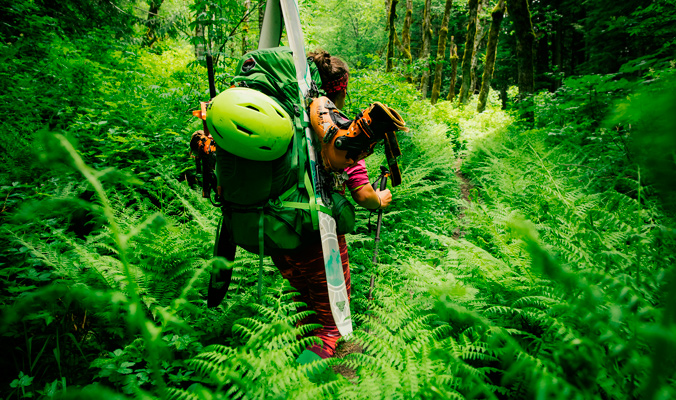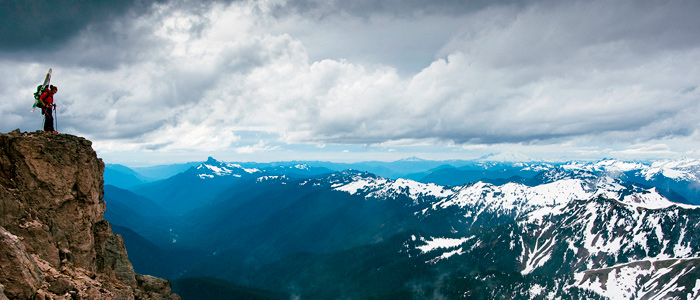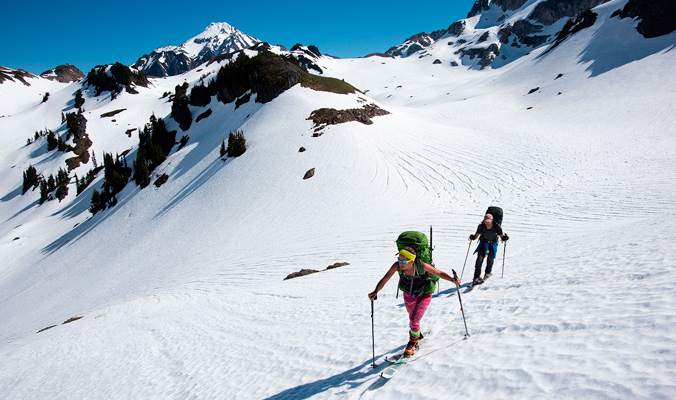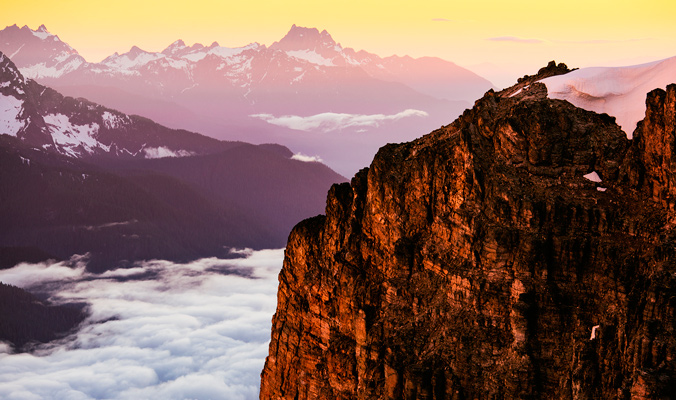Photographer Jason Hummel is a man on a mission—to ski all of the named glaciers in Washington State. He’s been working toward this goal for three years and, as a part of the saga, we covered his 2016 traverse of the Olympic Mountains.
Fast forward to this June, when mild spring weather opened up an opportunity for Hummel to check off a number of glaciers in the remote Glacier Peak region, as well as the Chilliwack Mountains that span the border between Canada and the U.S. Forging through temperate rainforest underbrush and unpredictable coastal weather, Hummel was able to tag another 20 glaciers in just one month.
We caught up with Jason Hummel to learn more about what these missions entailed and what he plans for the future of his glacier skiing project.

Kimberly Gardner begins the long approach along the Sauk River into Glacier Peak Wilderness. [Photo] Jason Hummel
Jason Hummel: There are approximately 213 officially named glaciers in Washington. And this year I only had part of May and June to work on the project because winter was too gnarly. There was so much snow. I think Baker got around 900 inches this year—that’s just the ski area—let alone what the places in the middle of nowhere got. So in spring, I had to be ready to go and get after it.
BCM: Was that the main challenge you were up against this season?
JH: My main challenge was the snow. This winter was the worst I’d seen in all my years as a ski mountaineer in Washington. We had two to four sunny days in six months.
Because of the weather, I put off my glacier project until spring. In Washington, we usually get a break in inclement weather by the end of the winter season. And, like clockwork, it came, but was temperamental.

Dan Chirpich and Kimberly Gardner make headway on the ascent of Glacier Peak. [Photo] Jason Hummel
JH: Access is the biggest difficulty besides weather. The long approaches to obscure locations raise the potential for washed-out roads, bridges and trails. There are waterfalls, bushwhacking and big, heavy packs. Most glaciers take anywhere from two to seven days to get to and then ski, so I try to tag a few at a time. But that’s getting harder the closer I get to finishing, because I have worked through many of the glaciers that are conveniently located near each other.

As storm clouds build, Gardner scouts the way and makes the decision to continue on rather than camp during the group’s circumnavigation of Glacier Peak. [Photo] Jason Hummel
JH: On Glacier Peak, many of the approaches are long and have gotten more difficult as access points have been closed due to road damage. My original plan was to ski in on one side of Glacier Peak and out the other. But I was concerned because, in the spring, river flows go up a lot, and I wasn’t one hundred percent sure I could make a safe crossing of the Suiattle River. I would have gone for it personally, but was traveling with two out-of-state ski tourers I hadn’t met before and I’m a nice guy, so I didn’t want to give them a poor introduction to the North Cascades.

Hummel continues his descent from the summit of Glacier Peak back to the gear he left behind after completing the circumnavigation of Glacier Peak. [Photo] Dan Chirpich
JH: The skiers that I had on that trip had been living in the back of their car for two years. They had good paying jobs and they just quit to go on the road. They met each other while they were each on the road, separately, and ended up moving into the same vehicle. They didn’t know anything about Washington, but they wrote me an email asking questions about the mountains up here—they didn’t realize that the Cascades aren’t the Sierra. The Cascades are much more convoluted terrain-wise, so I met up with them for a tour.
I was a bit nervous about taking them out because they were newish ski mountaineers and in the spring there’s often a freeze/thaw cycle; it makes any slips particularly treacherous, especially on cool mornings. So I was concerned, but it turned out great. We had a blast, and they got one heck of an adventure.

Chirpich and Gardner return to White Pass after a seven day journey circumnavigating Glacier Peak. [Photo] Jason Hummel
JH: I really enjoyed the Chilliwacks. It is probably my favorite area in the Cascades so far. That was the main instigator for the whole project; I wanted to get pushed out of my familiar haunts in the Cascades, and this project has been the impetus for that. I get to explore places near my home that I wouldn’t ordinarily travel to.

Sloan Peak stands tall within the Monte Cristo Range. [Photo] Jason Hummel
JH: I am doing this for myself. I’m not sponsored. I don’t make money at it. I love the Cascades; they are my heart and soul. I have a lifelong connection to them that has only grown stronger with age. The more I know them, the deeper that connection grows. If anything there will be a sadness when I am done because, in a sense, I’ve seen so much of it that I worry there will be little exploration left for me when I’m done.

Sunset sweeps over the cliffs of Kennedy Peak and the distant outlines of Whitehorse and Three Fingers mountains. [Photo] Jason Hummel
To see more of Jason Hummel’s photos and read about his travels, visit alpinestateofmind.com.










Related posts: